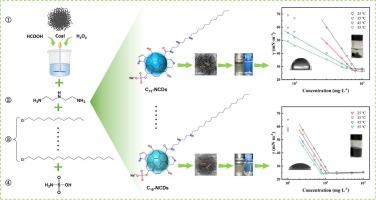烟煤衍生的两亲性氮掺杂碳点:增强油水界面活性和纳米材料分散性
IF 7.7
2区 工程技术
Q1 CHEMISTRY, APPLIED
引用次数: 0
摘要
煤炭资源的高效、清洁利用是实现碳减排和能源可持续发展的关键。在本研究中,以烟煤为原料,通过甲酸和过氧化氢介导的绿色氧化-解聚工艺,然后水热氮掺杂、烷基化和磺化,合成了一系列两亲性氮掺杂煤基碳点(C12 ~ C18-NCDs)。通过综合结构和界面表征,证实了NCDs具有可调节的两亲性。烷基链长度从C12增加到C18显著降低了临界胶束浓度(25℃时从802降低到121 mg/L),降低了CMC下的表面张力(从28.13降低到25.31 mN/m)。值得注意的是,C18-NCDs在10 wt% NaCl条件下获得了超低的油水界面张力(0.00119 mN/m),并在疏水石蜡表面表现出优异的润湿性(接触角为44.63°)。此外,两亲性NCDs在多壁碳纳米管(MWCNTs)中表现出出色的分散性,由于π -π堆叠相互作用、烷基链疏水锚定和磺酸基引起的静电斥力的协同作用,可以有效抑制聚集。这项工作提出了一种可扩展和可持续的方法,将煤转化为具有多功能特性的高级碳纳米材料,在石油界面工程、燃料乳化和纳米材料分散方面显示出良好的应用潜力。本文章由计算机程序翻译,如有差异,请以英文原文为准。

Amphiphilic nitrogen-doped carbon dots derived from bituminous coal: Enhanced oil-water interfacial activity and nanomaterial dispersibility
Efficient and clean utilization of coal resources is critical to achieving carbon emission reduction and sustainable energy development. In this study, a series of amphiphilic nitrogen-doped coal-based carbon dots (C12 ∼ C18-NCDs) were synthesized from bituminous coal through a green oxidation-depolymerization process mediated by formic acid and hydrogen peroxide, followed by hydrothermal nitrogen doping, alkylation, and sulfonation. The resulting NCDs exhibited tunable amphiphilicity, as confirmed by comprehensive structural and interfacial characterizations. Increasing the alkyl chain length from C12 to C18 significantly reduced the critical micelle concentration (from 802 to 121 mg/L at 25 °C) and lowered the surface tension at CMC (from 28.13 to 25.31 mN/m). Notably, C18-NCDs achieved ultra-low oil-water interfacial tension (0.00119 mN/m) under 10 wt% NaCl and exhibited excellent wettability on hydrophobic paraffin surfaces (contact angle: 44.63°). Furthermore, the amphiphilic NCDs demonstrated outstanding dispersibility for multi-walled carbon nanotubes (MWCNTs), effectively suppressing aggregation due to the synergistic effects of π–π stacking interactions, hydrophobic anchoring from alkyl chains, and electrostatic repulsion induced by sulfonate groups. This work presents a scalable and sustainable approach for converting coal into advanced carbon nanomaterials with multifunctional properties, showing promising potential for applications in petroleum interfacial engineering, fuel emulsification, and nanomaterial dispersion.
求助全文
通过发布文献求助,成功后即可免费获取论文全文。
去求助
来源期刊

Fuel Processing Technology
工程技术-工程:化工
CiteScore
13.20
自引率
9.30%
发文量
398
审稿时长
26 days
期刊介绍:
Fuel Processing Technology (FPT) deals with the scientific and technological aspects of converting fossil and renewable resources to clean fuels, value-added chemicals, fuel-related advanced carbon materials and by-products. In addition to the traditional non-nuclear fossil fuels, biomass and wastes, papers on the integration of renewables such as solar and wind energy and energy storage into the fuel processing processes, as well as papers on the production and conversion of non-carbon-containing fuels such as hydrogen and ammonia, are also welcome. While chemical conversion is emphasized, papers on advanced physical conversion processes are also considered for publication in FPT. Papers on the fundamental aspects of fuel structure and properties will also be considered.
 求助内容:
求助内容: 应助结果提醒方式:
应助结果提醒方式:


